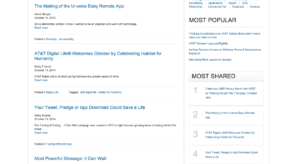This Halloween, I want to discuss a survival tactic for content marketing: avoiding the undead.
An undead or “zombie” blog is created when a website has a blog, but it’s never (or hardly ever) updated. So while it’s not alive, kicking, and contributing to the online community, it’s visible presence means it isn’t dead either. And much like zombies in the movies, an undead blog will devour your brand’s online reputation.
The Rise of Zombie Blogs
Zombie blogs are a common—if unintentional—mistake that brands make at various stages of their website’s life. Many companies slap a blog on their website because the catch phrase, “Content is King,” is becoming ever more popular and true. Unfortunately, some businesses are unprepared or unable to dedicate the necessary time to create, implement, and publicize a content marketing strategy successfully. This lack of resources is why more and more undead company blogs are popping up online.
Common Repercussions of Undead Blogs
Even if companies are up-to-date in their business practices, a disused blog will still make their brand appear out-of-date and untrustworthy. A blog can become undead when the blog’s content or appearance (or both) are dated.
Updating Content
Unlike most static content, readers expect each blog to be associated with its publication date and whether you like it or not, today’s readers inherently trust new content more than old content. In addition, the amount of time it takes for a blog to go from “new” to “old” is shrinking. Depending on the topic and where the content is viewed, your blog could be considered outdated after a month, a week, or even 30 minutes.
This speedy life cycle can make your blog go from fresh and trustworthy to undead and untrustworthy in only a matter of time. Your blog can liven up your brand by creating a distinct brand voice that can share your subject matter expertise in the community.
Updating Appearances
First appearances are everything. Unfortunately, no matter how much quality content you have on your blog, an ancient or lazy web design will send your blog back to the zombie zone. Sites that look “spammy” or in any way untrustworthy cause readers to quickly leave and look for a more accessible site. This pattern can destroy your company’s online reputation, which will eventually affect your brand’s perception in the marketplace.
The Consumer Blog that Consumed a Company: A Cautionary Tale
Even the most successful brands can ruin their reputation with a zombie blog. A few weeks ago, I attended a continuing education course at the University of Missouri St. Louis called “Blogs to Buzz.” The instructor was showing us examples of company blogs with varying degrees of blogging expertise. The first one was up-to-date and dynamic in both content and appearance. The second one was pretty, but hadn’t been updated in months. And the third one—belonging to AT&T—was updated regularly, but was stale in both content and appearance.
 Unlike the first two examples, the students literally laughed out loud when they saw the third blog. This reaction was probably partially from it’s ugly appearance and partially due to genuine surprise. AT&T is a competitive and successful company whose brand is practically a household name. In fact, their main products—internet and cellular service—automatically raises the public’s expectation that AT&T is tech savvy. Therefore, seeing the brand through the blog’s flawed lens was all the more startling.
Unlike the first two examples, the students literally laughed out loud when they saw the third blog. This reaction was probably partially from it’s ugly appearance and partially due to genuine surprise. AT&T is a competitive and successful company whose brand is practically a household name. In fact, their main products—internet and cellular service—automatically raises the public’s expectation that AT&T is tech savvy. Therefore, seeing the brand through the blog’s flawed lens was all the more startling.
Students began calling out the zombie blog’s flaws. From vague and uninformative titles to a bland, sterile appearance, the list for “What’s wrong with this blog?” was practically endless.
About five minutes into the roasting of AT&T’s “consumer” blog, one student raised her hand and announced that AT&T was her company’s client. An uncomfortable silence fell over the room as the student explained that AT&T was going through an overhaul of their content to their new blog, pictured below.
 What a difference! The new AT&T blog’s appearance and content was dynamic and accessible, practically fixing all the flaws we found in the consumer blog. Unfortunately, very little of that mattered because AT&T’s zombie blog was Google’s first link for “AT&T blog,” not the new, shiny, and accessible version.
What a difference! The new AT&T blog’s appearance and content was dynamic and accessible, practically fixing all the flaws we found in the consumer blog. Unfortunately, very little of that mattered because AT&T’s zombie blog was Google’s first link for “AT&T blog,” not the new, shiny, and accessible version.
In AT&T’s defense, the student gave some pretty good reasons for why their zombie blog existed. For instance, AT&T is a huge company with a huge amount of content to move from one blog to another: a difficult and time-consuming task. However, if it hadn’t been for that student’s explanation, no one would have ever known that there was another AT&T blog. Most importantly, they still could have avoided the zombie blog’s attack on their brand.
Always Put the User First
Many companies maintain undead blogs because they want to continue ranking well in search engines. While a site’s seniority can contribute to good keyword rankings, the whole point of ranking well is to bring new and returning visitors to your website, not to just appease the Google gods. Do you really want them to find your zombie blog and use that as their interpretation of your brand? In addition, search engines are focusing more and more on fresh, dynamic content to determine rankings. Generating fresh and relevant content to your industry will improve brand perception and boost your organic rankings.
Don’t Compete with Yourself
If you’re producing new, useful, and important content on a new blog and your undead blog still has better rankings for all your keywords, you’re only competing with yourself. Always put your best foot forward and ensure people see it by killing the zombie before it takes over your brand.
Use the Right Tools in Times of Transition
If you suspect readers may get angry at the sudden disappearance of content, cater to those visitors without harming new ones. Using tools such as “nofollow” cues in your links will keep search engines from crawling these pages. This way, previous readers of your blog can access the old site until your company moves it to the new one, preserving your reputation on all fronts.
Revive the Zombie or Kill It?
When you’re cursed with an undead blog, the two best scenarios are to revive the blog or kill it off. To decide which is the right call for you, it’s time to answer the hard questions:
- How important is our blog to the brand?
- Do I have the time and resources to commit to a fully-functional content marketing strategy?
People Don’t Go Back to Static Sites
While new visitors are great, returning visitors are the ones that convert the most and people don’t go back to static sites. A living blog that provides useful, dynamic content gives visitors a reason to return because they expect something on a regular basis. This regularity leads to higher rankings, better brand perception, and more online conversions. Therefore, if you consider your website essential to your company’s success, then quality content and a good user experience should be a top priority.
Maintaining a Blog Isn’t Easy
As stated before, undead blogs occur because they take a great amount of work, time, skill, and dedication. Here at jWeb, we recently decided to revive our content marketing strategy for our blog, so we know just how hard it can be to get things moving again. But we also know with the right assets, it’s possible to reap the benefits of that hard work. While some companies may not have the resources to maintain their blog, others are able to hire an in-house blogger or outsource their content marketing to an agency.


